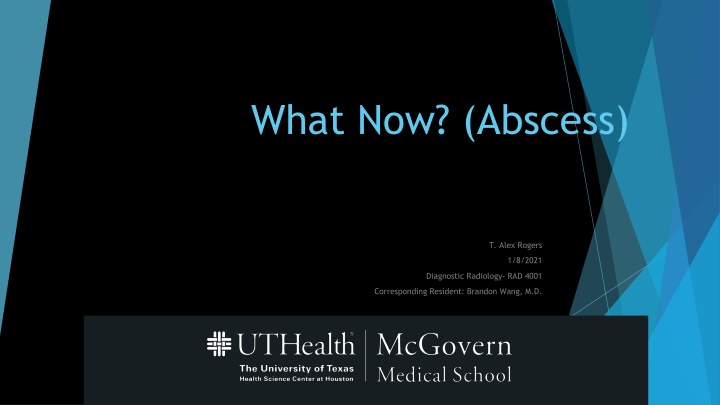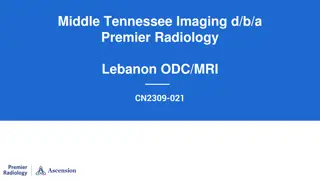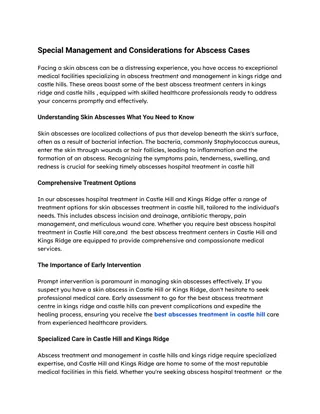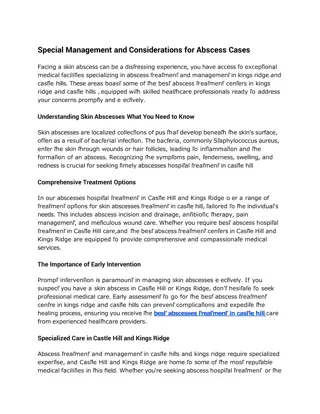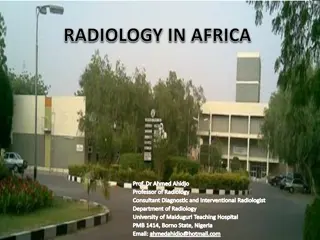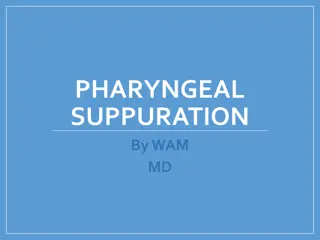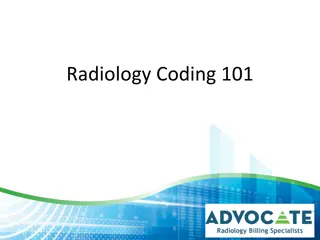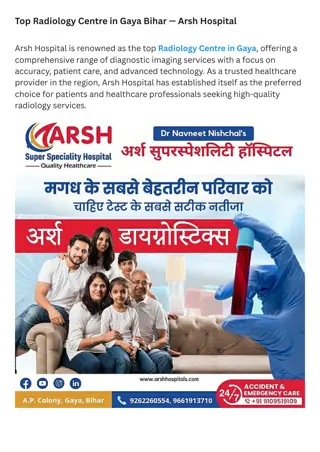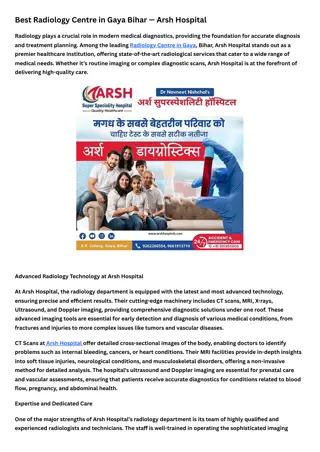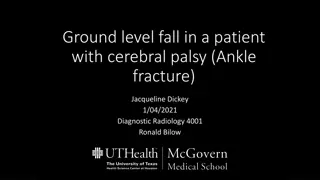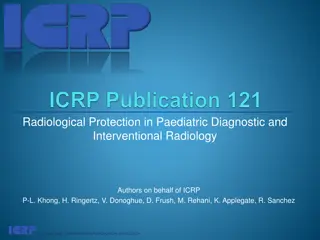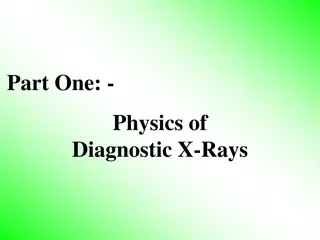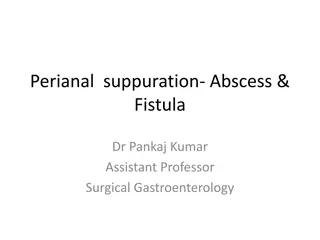Peripancreatic Abscess in a 35-Year-Old Male - Diagnostic Radiology Case Study
A 35-year-old male presented to the ER with abdominal pain. Imaging revealed a peripancreatic abscess, along with liver lacerations, an edematous gallbladder, and other findings. Key features include a previous history of surgeries and bullet fragment. The differential diagnosis includes peripancreatic abscess, acute pancreatitis, and seroma.
Uploaded on Oct 04, 2024 | 4 Views
Download Presentation

Please find below an Image/Link to download the presentation.
The content on the website is provided AS IS for your information and personal use only. It may not be sold, licensed, or shared on other websites without obtaining consent from the author.If you encounter any issues during the download, it is possible that the publisher has removed the file from their server.
You are allowed to download the files provided on this website for personal or commercial use, subject to the condition that they are used lawfully. All files are the property of their respective owners.
The content on the website is provided AS IS for your information and personal use only. It may not be sold, licensed, or shared on other websites without obtaining consent from the author.
E N D
Presentation Transcript
What Now? (Abscess) T. Alex Rogers 1/8/2021 Diagnostic Radiology- RAD 4001 Corresponding Resident: Brandon Wang, M.D.
Clinical History 35 year old male presenting to the ER for 3 days of continuous abdominal pain Pain is sharp and nonradiating Aggravating factors: eating, movement ROS: Positive for nausea and chills, all else negative PMH: Polysubstance abuse, HIV (untreated, CD4 unknown) PSH: Laparotomy with hemicolectomy, hepatorrhapy, ileostomy, ERCP with pancreatic duct stent placement, and GJ tube on 10/14/2020 Lipase at outside facility= 12,000 U
Physical Exam Afebrile (Now-was 101 F @ OSH) BP: 116/58 HR: 90 RR: 20 Abdominal exam: tender abdomen, non-distended. GJ in place with no signs of infection, midline incision healing, ostomy present with good output Labs: Lipase 12000 Hct/Hgb 37.6%/12.2 WBC: 23.4
Relevant Imaging A CT scan with IV contrast was obtained at the outside facility due to concern for an abscess or seroma in the pancreas Contrast: 100 mL Isovue 300
Relevant Imaging Patient s liver with a transection in segment 4 Normal anatomy of the liver https://web.stanford.edu/dept/radiology/radiologysite/sit e305.html
Relevant Imaging Normal anatomy of the abdomen https://www.radiologyinfo.org/en/info.cfm?pg=abdominct 4.0 X 3.9 cm mass near pancreatic head, peripancreatic fat stranding
Key Findings Liver: Left liver lobe laceration in segment 4 and right liver lobe laceration in segment 6 (originally noted in 10/2020 scans) Gallbladder: Edematous and thickened gallbladder wall. No stones Pancreas: Peripancreatic fat stranding, 4.0X 3.9 cm fluid collection abutting the pancreatic head, pancreatic duct stent in place Stomach: Percutaneous GJ tube in place Colon: Colostomy in right lower quadrant Bullet fragment noted at L2
Differential Diagnosis Peripancreatic Abscess Acute Pancreatitis with necrosis of the pancreatic head Seroma
Treatment Started on Cefepime (2 g TID) and Flagyl (500 mg TID) in ED Patient underwent CT-guided Percutaneous Aspiration on Hospital Day 2 Drainage of the postsurgical abscess is always the first-line treatment, and percutaneous drainage is preferred in most cases of abdominal abscess Percutaneous drainage of pancreatic abscesses is controversial, and it is a decision made by a multidisciplinary team of surgeons and interventional radiologists. CT guidance allows for positioning of the needle in 3 dimensions, and this is superior to fluoroscopic guidance. Complications include superinfection of a sterile fluid collection, bleeding, and bowel wall injury. Disadvantages are primarily the increased amount of radiation exposure during the procedure.
Post-CT-Guided Aspiration Aspiration of 14 cc of serous-appearing fluid with reduction in size of the mass
Final Diagnosis Acute Pancreatitis with necrosis and peripancreatic abscess Cultures grew out pansensitive Enterococcus
Discussion Inflammation of the pancreas and peripancreatic fat from immune response results in peripancreatic fat stranding and altered pancreatic density Introduction of bacteria during surgery results in a nidus of infection. Our patient s original CT scan demonstrated a walled-off pocket of fluid and peripancreatic fluid consistent with pancreatitis and an abscess. CT-guided drainage results in a >90% first treatment success rate Mortality rates of intra-abdominal abscesses ranges from 45%-100% depending on location and cause of the abscess if not treated.
ACR Appropriateness Criteria Given his history of major abdominal surgery less than 2 months prior, our patient with acute onset abdominal pain and fever was appropriately imaged with an abdominal CT with contrast.
ACR Appropriateness Criteria Even if physicians were only concerned about pancreatitis, an abdominal CT with IV contrast would have been considered appropriate. Our patient s history of surgery raises the possibility of some other diagnosis being the root cause of his abdominal pain.
Cost (Derived from MHH Master List Exam Cost Abdominal CT with IV Contrast CT-guided Cyst Aspiration Chest X-ray (1 view) $5540.00 $2656.50 $683.00 Total $8879.50 While hospitalized, our patient also complained of self-limited chest pain, resulting in an order for a chest x-ray. MHH Master Fee Schedule: https://www.memorialhermann.org/- /media/memorial-hermann/org/files/patients-and-visitors/standard-hospital- charges/charge-description-master-tmc.ashx?la=en
Take Home Points The cost of multiple scans adds up quickly, both in monetary value and radiation exposure Postsurgical abscesses have an extremely high mortality rate and require intervention First pass success in CT-guided aspiration of abscess is >90% with few complications Treatment of most intra-abdominal abscesses is preferred to be via percutaneous drainage rather than surgical
References https://web.stanford.edu/dept/radiology/radiologysite/site305.html https://www.radiologyinfo.org/en/info.cfm?pg=abdominct https://www.empr.com/drug/isovue-300/ https://acsearch.acr.org/docs/69467/Narrative/ Roberts BW. CT-guided Intra-abdominal Abscess Drainage. Radiologic Technology. 2015;87(2):187CT-207CT. De Waele J, Vogelaers D, Decruyenaere J, De Vos M, Colardyn F. INFECTIOUS COMPLICATIONS OF ACUTE PANCREATITIS. Acta Clinica Belgica. 2004;59(2):90- 96. doi:10.1179/acb.2004.013 Lee MJ. Non-traumatic abdominal emergencies: imaging and intervention in sepsis. European Radiology. 2002;12(1):2172-2179. doi:10.1007/s00330-002- 1570-4
